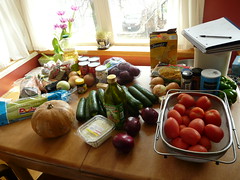 Whether you are dating or married, one of the best ways to maintain closeness in your relationship is to have a date night. However, with the high cost of entertainment, dating can put a serious kink in your budget, but it does not have to. Here are some frugal date suggestions that will kindle your relationship and protect your wallet.
Whether you are dating or married, one of the best ways to maintain closeness in your relationship is to have a date night. However, with the high cost of entertainment, dating can put a serious kink in your budget, but it does not have to. Here are some frugal date suggestions that will kindle your relationship and protect your wallet.
-Cook together. Dates don’t always have to entail a dinner and a movie. Consider making a meal together. My husband and I both love to cook and eat, so during our courtship we frequently cooked together. We tried new recipes and varied what we prepared. Sometimes we would make an economical stir-fry, while other times we bought crab legs from the grocery store and treated ourselves. We bought the crab legs on sale for $9.99; still much cheaper than a night out on the town, and we could talk while we cooked.
-Go to a free concert. If you live in a metropolitan area or near a college town, there is no shortage of free events. Take advantage of them and plan your date around the event. We attend blues festivals and food festivals as well as concerts in the park. They provide several hours of enjoyable entertainment for free.
-Rent a movie. Rent a movie or two from Redbox or the local library. Redbox only charges $1 per movie, and the local library may offer them for free or for a nominal fee for $1 or $2.
-Star gaze together. If you live in a rural area, take advantage of the darkness and put out a blanket on the ground and gaze at the stars together. My husband and I bought a constellation map and spent hours trying to identify all of the constellations. It’s also fun to watch shooting stars.
-Hike together. If you live somewhere with trails or hiking paths, take a hike together. It is free, and you can’t compete with the beautiful scenery.
-Have a picnic. In this modern society where we are trained to go, go, go, it seems simple to pack a meal and have a picnic somewhere, but you will appreciate the time to talk and just focus on one another. My husband and I frequently went to a local waterfall in the evenings and just talked. It was so refreshing to hear the water in the background, and the scenery was amazing.
-Grab a bite to eat during happy hour. Many restaurants offer ½ off appetizers between the hours of 3 and 5 and after 9 p.m. Plan to dine out during that time and enjoy some half-price appetizers. (This is fun to do sometimes; I went to grad school with a guy who would only take his dates out for half price appetizers. I am still amazed that he found girls to go out with him.)
If you go the traditional route of dinner and a movie for a date, you could spend upwards of $50 for two people for just a few hours of entertainment. Instead, try some of these frugal date suggestions or alternate expensive dates with more frugal dates. After all, the point of dating is to have fun and enjoy one anothers company, not spend as much money as you can. Enjoy!
Melissa is a writer and virtual assistant. She earned her Master’s from Southern Illinois University, and her Bachelor’s in English from the University of Michigan. When she’s not working, you can find her homeschooling her kids, reading a good book, or cooking. She resides in New York, where she loves the natural beauty of the area.


